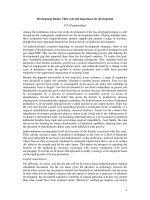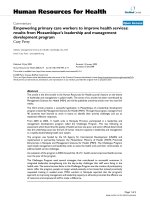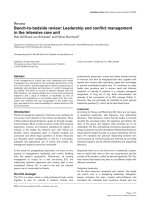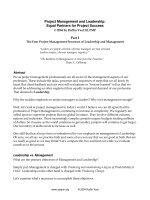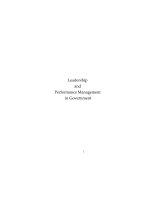Building In-House Leadership and Management Development Programs- Their Creation, Management, and Continuous Improvement
Bạn đang xem bản rút gọn của tài liệu. Xem và tải ngay bản đầy đủ của tài liệu tại đây (2.82 MB, 699 trang )
Cover
title:
author:
publisher:
isbn10|asin:
printisbn13:
ebookisbn13:
language:
subject
publicationdate:
lcc:
ddc:
subject:
BuildingIn-houseLeadershipand
ManagementDevelopmentPrograms:
TheirCreation,Management,and
ContinuousImprovement
Rothwell,WilliamJ.;Kazanas,H.C.
GreenwoodPublishingGroup
1567202586
9781567202588
9780585384276
English
Executives--Trainingof,Supervisors-Trainingof,Organizationalchange--Study
andteaching,Leadership.
1999
HD30.4.R681999eb
658.4/07124
Executives--Trainingof,Supervisors-Trainingof,Organizationalchange--Study
andteaching,Leadership.
Pagei
BuildingIn-House
LeadershipandManagement
DevelopmentPrograms
Pageii
Thispageintentionallyleftblank.
Pageiii
BuildingIn-House
LeadershipandManagement
DevelopmentPrograms
TheirCreation,Management,
andContinuousImprovement
WilliamJ.Rothwell
andH.C.Kazanas
Pageiv
LibraryofCongressCataloging-in-PublicationDataRothwell,WilliamJ.,
1951–
Buildingin-houseleadershipandmanagementdevelopment
programs:
theircreation,management,andcontinuousimprovement/WilliamJ.
RothwellandH.C.Kazanas.
p.cm.
Includesbibliographicalreferencesandindex.
ISBN1–56720–258–6(alk.paper)
1.Executives—Trainingof.2.Supervisors—Trainingof.
3.Organizationalchange—Studyandteaching.4.Leadership.
I.Kazanas,H.C.II.Title.
HD30.4.R681999
658.4′07124—dc2199–14846
BritishLibraryCataloguinginPublicationDataisavailable.
Copyright©1999byWilliamJ.RothwellandH.C.KazanasAllrights
reserved.Noportionofthisbookmaybereproduced,byanyprocessor
technique,withouttheexpresswrittenconsentofthepublisher.
LibraryofCongressCatalogCardNumber:99–14846
ISBN:1–56720–258–6
Firstpublishedin1999
QuorumBooks,88PostRoadWest,Westport,CT06881
AnimprintofGreenwoodPublishingGroup,Inc.
www.quorumbooks.comPrintedintheUnitedStatesofAmerica
ThepaperusedinthisbookcomplieswiththePermanentPaper
StandardissuedbytheNationalInformationStandardsOrganization
(Z39.48–1984).
1098765432
Pagev
To
MarcelinaRothwellandNuriaKazanas
Pagevi
Thispageintentionallyleftblank.
Pagevii
Contents
Preface
ix
I.LeadershipandManagementDevelopment:BackgroundIssues 1
1.DefiningLeadershipandManagementDevelopment
3
II.PlanningandDesigningtheLeadershipandManagement
DevelopmentProgram
31
2.FocusingaLeadershipandManagementDevelopmentProgram 33
3.IdentifyingLeadershipandManagementDevelopmentNeeds
53
4.EstablishingaLeadershipandManagementDevelopment
Curriculum
75
5.AdministeringaLeadershipandManagementDevelopment
Program
89
III.Selecting,Planning,andUsingFormal,Informal,andSpecial
Methods
115
6.HowShouldRecruitmentandSelectionBeUsedasPartofa
LeadershipandManagementDevelopmentProgram?
117
7.PlanningandUsingFormalMethods
127
8.PlanningandUsingInformalMethods
181
9.PlanningandUsingSpecialMethods
203
Pageviii
IV.EvaluatingLeadershipandManagementDevelopmentMethods
andPrograms
221
10.EvaluatingMethodsandPrograms
223
11.Epilogue:SpecialIssuesinLeadershipandManagement
Development
243
Bibliography
259
Index
273
Pageix
Preface
Managementplaysthekeyleadershiproleinplanninganddeploying
organizationalassets.Managementdecisionsdramaticallyaffectthelives
ofotherpeople.Indeed,managementemployeesmakestrategic
decisionsaboutlayoffs,mergers,acquisitions,expansions,union
negotiations,andbankruptcyfilings.Theyalsomaketacticaldecisions
aboutworkgroupstructureandindividualpayincreases,promotions,
demotions,dismissals,andtransfers.Whilepresenttrendspointtoward
lessarbitrarymanagementdecisionmakinginanefforttoimprove
productivityandproductorservicequalitythroughincreasedemployee
involvement,managementcontinuestoplayakeyleadershiprole
whethereffortsarefocusedonauthoritativelydirectingtheworkofothers
orparticipativelyguidingit.
Atthesametime,workersatalllevelsareincreasinglybeingencouraged
—andcalledupon—toexertleadership.Indeed,leadershipisnotfor
managementalone.Forthisreason,then,manyforward-thinking
decisionmakersaresponsoringLeadershipandManagement
Development(L&MD)programsintheirorganizations.Thegoalofsuch
programsistoencourage,support,andnurturebothleadershipand
managementdevelopment.
THEPURPOSEOFTHISBOOK
Manypeopleweknowhavebeenaskedtoestablish,maintain,renew,or
evaluateanL&MDprogram.Rarelydotheyknowwheretoturnforhelp.
Theyinventtheirownjobdescriptionsandstruggletosatisfythe
(sometimesconflicting)preferencesofexecutives,managers,and
supervisorswhoseetheneedforaplannedL&MDprogrambutdonot
knowhowtoestablishandoperateonesuccessfully.
Pagex
WhilemanybooksandarticleshavebeenwrittenaboutL&MD,few
booksprovidepracticalguidanceforthosestartinguporrenewinga
plannedL&MDprogram.Wewrotethisbooktoserveasapractical,
how-to-do-itmanualforestablishingandadministeringaplanned
ManagementDevelopment(L&MD)programgearedtoaddressingthe
training,education,anddevelopmentneedsofsupervisors,managers,
executives,andotherswhoexertleadershipinorganizationalsettings.Its
purposeistoslakethegrowingthirstforinformationaboutsuccessfulL&
MDprograms.
Youmayhaveheardalreadythatmanylargeorganizationshaveenjoyed
immensesuccesswithplannedL&MDprograms.Smallorganizations
havealsobenefitedfromthem,thoughtheirtriumphsareusuallyless
widelypublicized.Manyofyoumayhavealreadyworkedin—orvisited—
high-performingorganizationsinwhichL&MDprograms,whilenot
overtlyvisible,playimportantrolesinstrategicandtacticaldecisionsand
actions.
Whateveryourinterests,thisbookisintendedtogiveyouuseful,
practicalinformationonhowtoplan,establish,manage,operate,and
evaluateaplannedL&MDprograminanorganizationalsetting,based
onwhatisknownaboutbestpractices.
SOURCESOFINFORMATION
Aswetookupthetaskofwritingthisbook,wedecidedthatitwas
importanttobaseitonstate-of-the-artpractices.Tothatend,we
consultedseveralmajorsourcesofinformation:
1. Atailor-madesurvey.Asaninitialstepinresearchingthisbook,
WilliamJ.RothwellsurveyedL&MDprofessionalsin1998about
practicesintheirorganizations.Thesurveyresultsarepublished
inthisbookforthefirsttime.
2. Aliteraturesearch.Weconductedanexhaustiveliteraturesearch
onL&MD.Weprovidekeyreferencesthroughoutthebooksoyou
candelvefurtherintoissuesofspecialinteresttoyou.
3. Firsthandexperience.Thefirstauthorofthisbookisan
experiencedL&MDprofessional.Thefruitsofhisexperienceare
reflectedinthisbook.
THESCHEMEOFTHISBOOK
BuildingIn-HouseLeadershipandManagementDevelopmentPrograms
iswrittenprimarilyforL&MDspecialists,humanresourcedevelopment
(HRD)specialists,WorkplaceLearningandPerformance(WLP)
practitioners,andhumanresourcemanagers.Butthebookalsocontains
valuableinformationforchiefexecutiveofficers,chiefoperatingofficers,
generalmanagers,universityfacultymemberswhodoconsultingonL&
MD,andotherpeoplewhobearresponsibilitiesfordeveloping
managementtalent.
Thebookisdividedintofourmajorparts.PartIconsistsofonechapter,
Pagexi
whichservesasthebook’sprologue.Initweprovidebackground
informationaboutL&MD.Morespecifically,wedefineaplannedL&MD
program,distinguishbetweentraining,education,anddevelopment,
explainthepurposesofaplannedL&MDprogram,describethescope
ofL&MDactivitiesintheUnitedStates,distinguishplannedfrom
unplannedL&MDefforts,summarizemajorbarrierstoaplannedL&
MDprogram,andexplainwaystoovercomethosemajorbarriers.
PartIIconsistsofChapters2through5.Itfocusesonplanningand
designingL&MDprograms.
Chapter2describeshowto
1. Setupacommittee
2. DeterminethepurposeofaplannedL&MDprogram
3. Establishprogramgoalsandobjectives
4. Targetgroupstobeserved
5. Prepareaprogrampolicyandphilosophy
6. Prepareaflexibleactionplantoguideprogramstartup
7. Establisharegularscheduletoreviewprogramresults
TheseareinitialstepsinthestartupofmostplannedL&MDprograms.
InChapter3weturntoidentifyingL&MDneeds.Thischapteris
importantbecauseL&MDiscarriedouttomeetindividual,group,and
organizationallearningneedsanddesignedtoimproveindividual,group,
andorganizationalperformance.Wedistinguishbetweenlearningand
nonlearningneedsandexplainwhencorrectiveactionsotherthan
training,education,ordevelopmentarewarranted.Themostimportant
partofthischapterfocusesonmethodsforcollectingandanalyzing
informationaboutL&MDlearningneeds.
InChapter4wedescribehowtoestablishalong-termlearningplanto
meetpredictablelearningneeds.Wecallsuchaplanacurriculum,and
weexplainhowacomprehensiveL&MDcurriculumisdesignedand
summarizedifferentwaysbywhichtodesignanL&MDcurriculum.
Chapter5posesthefollowingquestions:
1. WhereshouldtheL&MDfunctionbepositionedinthe
organization’sreportingstructure?
2. Whatrewardsorincentivesshouldbeofferedtomanagementto
encouragememberstoacceptresponsibilityfordeveloping
themselvesandthosereportingtothem?
3. WhatkindofleadershoulddirecttheplannedL&MDprogram?
4. Howshouldtheprogramleaderberecruited,selected,and
oriented?
5. Howshouldinternalstaffmembersandexternalvendorsbe
selected,oriented,andtrained?
6. HowshouldplannedL&MDactivitiesbescheduled?
Pagexii
1. Howshouldbudgetingbehandled?
2. WhatrecordsofL&MDactivitiesshouldbekept?
3. HowshouldL&MDprogramactivitiesbepublicized?
PartIII,consistingofChapters6through9,describesformal,informal,
andspecialL&MDmethods.Weusethetermmethodtomeanan
organizedwaybywhichtomeetlearningneedsandthusbringabout
individualorgroupchangethroughlearning.Formalmethodsare
planned.Theyareusuallyfocusedonmeetinggrouplearningneeds.
Informalmethodsarenotplanned.Theyareusuallyspontaneously
focusedonmeetingindividualneeds.Specialmethodsareonthecutting
edgeofpractice.Sometimestheycanbecontroversial.
Chapter6providestwomodelstohelpselectappropriateL&MD
methodstomeetidentifiedneeds.
Chapter7focusesonplanningandusingformalL&MDmethods.These
methodsincludesuccessionplanningprograms,managementcareer
planningprograms,internalgrouptrainingprograms,externalgroup
trainingprograms,externaleducationprograms,jobrotationprograms,
andpositionassignmentprograms.
Chapter8focusesonplanningandusinginformalL&MDmethods,such
ason-the-jobmanagementtraining,on-the-jobmanagementcoaching,
managementmentoringorsponsorship,managementself-development,
andmanagementself-study.
Chapter9focusesonplanningandusingspecialL&MDmethods.
Amongthem:adventurelearning,NewAgeTraining(NAT),andaction
learning.
PartIVconsistsofChapter10only.Inthischapterwedefineevaluation.
Wealsodescribedifferenttypesofevaluation,keyobstaclesto
evaluation,methodstoovercomethoseobstacles,andastep-by-step
approachforconductingaprogramevaluation.
TheEpiloguefocusesonthreespecialissuesaffectingL&MD:
globalism,downsizing,andteam-basedmanagement.Ouraiminthis
finalchapterisnottoaddresstheseissuesexhaustively;rather,we
explaintheissuesandprovidegeneralguidanceaboutreviewingand
revampingL&MDprogramsinlightoftherecent,pervasiveinfluenceof
theseissues.
Finally,aBibliographyclosesthebook.Itcontainsnotonlythenotesfrom
allchaptersbutalsoadditionalresourcesthatcanleadreadersonto
othercurrentworksandresearchonLeadershipandManagement
Development.
Page1
PartI
LeadershipandManagementDevelopment:Background
Issues
PartIprovidesbackgroundinformationaboutLeadershipand
ManagementDevelopment(L&MD).WeintroduceChapter1witha
realisticcasestudy.PlannedL&MDprogramsoftenoriginatefrom
effortstohandleanisolatedcrisisliketheonedramatizedinthecase
study.InChapter1wealso:
DefineaplannedL&MDprogram
Distinguishbetweenmanagementtraining,education,and
development
ExplainthereasonsforaplannedL&MDprogram
DescribethescopeofL&MDactivitiesintheUnitedStates
DistinguishbetweenplannedandunplannedL&MDefforts
SummarizemajorbarrierstoaplannedL&MDprogram
Explainwaystoovercomethosemajorbarriers
Page2
Thispageintentionallyleftblank.
Page3
Chapter1
DefiningLeadershipandManagementDevelopment
INTRODUCTORYCASESTUDY
JosephineIronsisworried.Asexecutiveinchargeofalargedivisionina
prominent,well-known,andfinanciallystablebank,shehasjustreceived
wordthatLeahSmith,oneofhermostexperiencedsupervisors,will
retireinthreemonths.Leah,a23-yearbankveteran,supervisesa
criticallyimportantworkunitof30employees.Leahhasalsobeenan
outstandingworkerandhasbeeninfluentialinmakingmanypositive
changestoherworkunit.
TheannouncementofLeah’sretirementdoesnotcomeasacomplete
surprisetoJosephine.Thebankrecentlyextendedagenerousearly
retirementoffertolong-serviceemployees.Josephinehasknownforsix
monthsthatLeahwouldqualify,butLeahdidnotindicateuntilrecently
thatshewouldaccepttheoffer.Amidpainfulcost-cuttinganddownsizing
efforts,Josephine’sdivisionhasbecomesoshorthandedthatshefeels
luckytobegettingtheworkoutatall.Insomeareasheremployeeshave
beenworking600hoursofovertimeannuallytoholddownstaffingneeds
andemployeebenefitexpenses.Leahisnottheonlysupervisor
Josephinewillbelosingtoretirement.ButLeah’sdepartureposesthe
greatestproblembecauseJosephinehasnotpreparedanyoneto
assumeLeah’simportant,technicallyoriented,andtough-to-master
position.
JosephinecanfillthevacancycreatedbyLeah’sretirementinseveral
ways.Onewayistopromotefromwithin,gamblingthatsomeonefrom
Leah’sworkunitcanmasterthejobinareasonabletime.Inthisprocess
sheknowsshecanalwaysaskforLeah’sopinionaboutwhich
employeeshavethebestpotentialforsuccessinthejob.Promotionfrom
withinisthebank’stime-honoredmethodoffillingsupervisoryopenings.
Infact,manyemployeesexpectanewsupervisortobepromotedfrom
withintheworkunit.Somewillbeupsetifthevacancy
Page4
isfilledinanyotherway.Unfortunately,Josephineisnotconvincedthat
anyoneintheworkunitiscapableofmasteringLeah’sduties.
Josephinehasotherwaystofillthevacancy.Shecanaskother
executivesinthebanktonominateemployeeswithmanagement
potentialfromtheirdepartments.Ifchosen,suchacandidatewouldbe
promotedorwouldreceivealateraltransfertoLeah’sposition.But
Josephineknowsthatmovingaworkerfromanotherareawilltouchoff
movesalloverthebankasareplacementissoughtforeachvacated
position,aproblemcomplicatedbytheearlyretirementoffer.Norwillitbe
aneasytasktoconvinceothermanagerstogiveupatrainedworker—
evenforapromotion.Duringdownsizing,somemanagershoardworkers
sotheyneednotjustifyreplacementsortakeprecioustimetotrain
newcomers.Tomakemattersworse,thebankhasnocentralizedskillor
staffinginventoryandhastemporarilysuspendedjobpostingfor
supervisorypositions.Josephine’seffortstorecruitaqualifiedcandidate
insidethebankwillthusbecomplicatedbylackofinformation.Itcould
provetobetime-consuminganddifficult.
Josephineisalsoawarethatshecouldhireasupervisorfromoutsidethe
bank.Thatoption,Josephineworries,isaminefieldofpotentially
explosiveproblemsbecause‘‘outsiders”haveestablishednotrackrecord
insidethebank.Inanycase,Josephinewouldclearlywantsomeonewith
bankingindustryexperience,preferablysomeonewhohasworkedat
anotherbankinapositionsimilartoLeah’s.Althoughsuchpeopleexist,
theyarerare.Recruitingonewillnotbeeasy.Evenifasuitablecandidate
canbelocatedandhired,heorshewilllackjob-specificand
organization-specificknowledgeaboutthisbank’suniqueproceduresand
culture.Anewhire,nomatterhowexperienced,alsolacksasocial
supportnetworktoeasethetransitionfromoutside.Unexpectedturnover
inLeah’spositionisanunpleasantprospectforJosephine.Butthebank
doesnothaveagoodrecordofretainingthosehiredfromoutsidetofill
supervisorypositions.Newcomerstoooftenbecometurnoverstatistics.
Afourthwaytodealwiththevacancy,Josephineknows,istorestructure
thedivisiontoeliminatetheneedforLeah’sposition.Ifthatmoveresults
inreducedstaffing,itwillundoubtedlypleasetheCEO,Josephine’sboss,
becauseitwillreducethebank’soperatingexpenses.ButLeah’sduties
willhavetobeshiftedsomewhere—probablytoothersupervisors—and
Josephinefeelsthattheyhavealreadybeensaddledwithtoomuchwork.
Throughtheirfacialexpressionsandoccasionalcomments,theyshow
evidencethatstressandovertimearetakingtheirtoll.Josephineis
reluctanttopushthemanyharderforfearthatseveralmightquit.That
wouldonlyintensifyherstaffingproblems.
Afifthwaytodealwiththevacancyistoeliminatetheneedforany
supervisorbymakingLeah’sunitaself-directedworkgroup.IfJosephine
chosethatoption,shewouldredistributeLeah’sworktoemployeesofthe
unit.Josephinewouldliketoexperimentwiththispromising,popularnew
approachdesignedtoincreaseemployeeinvolvement.Butsherealizes
thatemployeesmustfirstbetrainedinhowtosupervisethemselves.
Threemonthsisnotlongenoughto
Page5
introducesucharadicalchangetotheworkunit’sculture,which(likethe
bank)haslongbeenmanagedwithatop-downapproachtodecision
making.Theworkers,Josephineknows,arepresentlyill-preparedto
acceptsucharadicalshiftofresponsibility.(However,Josephinewillbear
thisideainmindforthefutureandperhapsintroduceitatalatertime.)
Despiteallthesepossibilities—andJosephinecanthinkofothersaswell
—sheremainsunsureofwhattodoaboutthependingvacancyinLeah’s
position.Butsheknowssheisnotaloneinfacingaproblemofthiskind.
Theearlyretirementofferaffectstoomanyotherpeopleandpositions.
Perhapsitistime,Josephinereasons,tosuggestthatthebankintroduce
aplannedLeadershipandManagementDevelopment(L&MD)program.
Whilestartingupsuchaprogramnowwillnothelpsolvetheimmediate
problemcreatedbyLeah’searlyretirement,itmayhelpavoidsimilar
staffingdilemmasinthefuture.Moreover,Josephinewasnotallthat
happyaboutthe“sinkorswim”approachsheexperiencedwhenshe
enteredmanagement.Shefeelsthattheremustbebetterwaystotrain,
educate,anddeveloppeople.Sheresolvestofindout.
WHATISLEADERSHIP?
Inthecaseabove,Josephineislookingforsomeonetoexertleadership
aswellassomeonetofillamanagementvacancy.Manydefinitionsof
leadershiphavebeenofferedovertheyears.Amongotherdefinitions,
leadershiphasbeendescribedas:
“Directingtheactivitiesofagrouptowardasharedgoal.”1
“Theprocessofinfluencingtheactivitiesofanorganizedgroup
towardgoalachievement.”2
“Theabilitytostepoutsidetheculturetostartevolutionarychange
processesthataremoreadaptive.”3
Thesedefinitionsshareacommonthread:leadershipisnotlinkedto
positionbutislinkedtotheabilitytoinfluenceothers.
WHATISMANAGEMENT?
Managementisassociatedwithposition.Individualswhoaresaidtobe

